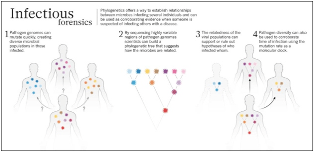Phylogenetics has deemed to be a very vital method to identify relationships between microorganisms and has now entered into solving criminal investigations. Phylogenetics can be defined as the study of the evolutionary relationships between species, individuals or even the genes. Phylogenetics now has found its way as a vital technique in forensics identifying the path of may be a bacterial or viral infection. It is referred to as Phylogenetics forensics. This technique is the amalgamation of evolutionary biology methods and forensics. One example as published by González-Candelas et.al (2013), of this method can be seen in identifying an anthrax laced heroin being circulated across Europe and tracing its origin.
Many such incidences of phylogenetic forensics are recorded across the world where it has helped to crack tricky cases and nab the criminals. Let’s see one such case. Anesthetist Juan Maeso of Valencia, Spain was convicted of spreading Hepatitis C viral (HCV) infection to more than 275 patients who came under his contact as he was working in two hospitals over the span of 10 years. Out of the people those were infected, 4 died from the complications arising from hepatitis C. He was sentenced to 1993 years in prison. The interesting thing to be noted here is the way Mr. Maeso was convicted. The doctors at the Spanish hospitals started noticing that there were people in clusters who were getting diagnosed with HCV. One Dr. Manuel Beltran, identified this as he was reviewing the medical records. The common thread amongst all the patients was that they all had surgery in the Hospital Casa de Salud in Valencia. Local authorities were contacted to understand the trends which in turn lead to a massive investigation analyzing the records of more than 66000 patients. Authorities figured out the only common thread amongst the people with HCV were Mr Maeso. To have solid evidence against him, Phylogenetic analysis of HCV was done.
Virus like HIV, HCV and Influenza are known to mate and mutate very rapidly. Scientist sequenced the viral samples from the infected patients and compared their genomes. By pointing out the minor differences in the genome, scientists were able to construct a Phylogenetics tree. [see the image for the viral evolution]

The case of Juan Maeso is one of the many where phylogenetic forensics aided to convict him.The use of such methods in the legal arena has made many people quinsy. Scientist says that unlike the definitive evidence which the DNA provides, phylogenetic analysis is never very accurate and cannot prove the guilt. There is also a concern amongst the lawyers and the scientists that there is a stigma attached to tracing the infection pattern especially for HIV infection and AIDs. Scientists, experts and lawyers are now in the process of setting guidelines so that this method can be used in proper legal framework and the prosecution officers will be aware of the powers and limitations of this technique.
